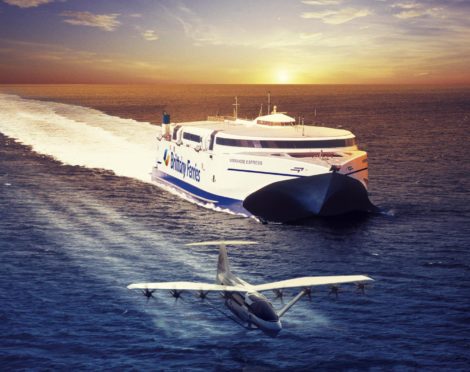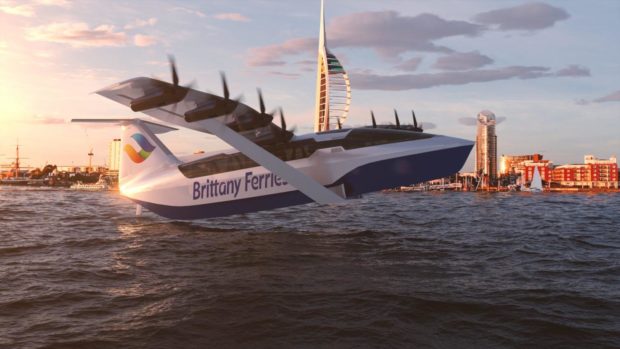Forget slow, lumbering boats: a revolutionary “flying ferry” could be the future of inter-island transport in Scotland.
The proposed zero-emission seagliders are to be powered by electric batteries.
The craft looks rather like a 20th-century seaplane aircraft but skims across the waves like a modern hydrofoil.
It’s being developed by leading cross-Channel ferry line Brittany Ferries in collaboration with US-based start-up Regent Craft.
It is hoped to be in service by 2028, carrying between 50 and 150 people at speeds of up to 180mph – many times faster than traditional boat journeys.
Aberdeen to Lerwick in under two hours
Right now the project is primarily aimed at cutting travel times across the English Channel.
But some 600 miles north, there are several parties watching the new project with interest – and with Scotland’s many archipelagos in mind.
The developers say the battery-powered craft, which is described as part-ship, part-plane, could reduce sailing times between Portsmouth and France from five hours by conventional ferry to just 40 minutes.
By the same calculation, the ferry from Lerwick to Aberdeen could be reduced from 13 hours to less than two. The boat from Stornoway to Ullapool might take under 20 minutes.
“It works by trapping a pocket of air between a wing and the surface of the water, then you can ride on that pocket of air almost as if you’re on one of those levitating trains in Japan,” said Nigel Wonnacott, a spokesman for Brittany Ferries.
“As long as you can sit on that cushion of air, you can move pretty big loads quite a long way very efficiently and easily.
“That’s one of the reasons why it uses battery-aided technology, because you don’t need too much power to get the thing moving.”
Could ‘flying ferries’ cope with Scottish weather?
That might be true on a flat calm day, but any new technology must be able to hold its own against wind, waves and driving rain.
“There are big technical challenges to overcome,” Mr Wonnacott said.
“How stable would it be over long distances on a body of water like the English Channel or the North Sea for example, where you’re dealing with highly exposed and quite volatile seas?”
Regent Craft acknowledged its plan for the flying ferries will face “technical and regulatory challenges”, but insisted that “shouldn’t be a barrier to developing a promising, sustaining technology”.
Mr Wonnacott agrees, saying that these concerns don’t mean the project can’t be done. “Regent are convinced they can do it and once we have the prototypes in action it will be much easier to make that sort of judgement,” he said.
Many of Scotland’s island communities depend on ferry links for nearly all aspects of life, but are often let down by timetabling and reliability issues.
Several of the current ferry services have also been criticised for being slow and congested, suggesting that it might be time for some new technology in the sector.
Could this be a ‘revolutionary change’?
Na h-Eileanan an Iar MP Angus MacNeil believes that thinking outside the box is key for bringing real change to island travel links.
“Anything that can get you from A to B faster and more efficiently is beneficial to islanders,” he said.
“The Scottish Government are planning to spend £580m on ferries in the next five years, and though 2028 is quite far away, I think it’s well worth keeping an eye on this sort of technology.
“Especially if we carry on as we are without tunnels or fixed links to the mainland. This could well be a revolutionary change.
“There’s two big things they’re doing here – zero emissions and decreased journey times.
“It will be interesting to see what sort of sea states might affect this sort of craft. For example, does it need a fairly flat sea or can it deal with a moving surface, and what sort of wave heights it can tolerate.
“This is certainly something for Transport Scotland to investigate along with fixed links and tunnels.”
Leader of Argyle and Bute Council Robin Currie is equally as interested to see how the flying ferries progress, but reiterated that islanders don’t want to be waiting until 2028 to see any changes.
“Argyll and Bute’s island and peninsula communities depend on ferry links for all aspects of life – they truly are lifeline routes,” he said.
“That’s why we continue to press for improvements to the existing network. This urgently needs more capacity so that timetabling pressures can be addressed, our residents can reliably access medical, social, business and employment opportunities and our visitors can travel easily to and from the area.
“This proposal is for longer cross-Channel routes and is in the very early stages. It will be interesting to see its progress and exactly how it will be implemented in terms of infrastructure and cost as well as practical considerations like weather conditions and environmental impact.”



